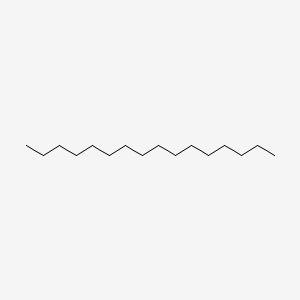| MeSH term | MeSH ID | Detail |
|---|---|---|
| Lupus Erythematosus, Systemic | D008180 | 43 associated lipids |
| Body Weight | D001835 | 333 associated lipids |
| Coronary Disease | D003327 | 70 associated lipids |
| Peritonitis | D010538 | 38 associated lipids |
| Hyperplasia | D006965 | 34 associated lipids |
| Glomerulonephritis | D005921 | 35 associated lipids |
| Encephalomyelitis, Autoimmune, Experimental | D004681 | 26 associated lipids |
| Keratosis | D007642 | 9 associated lipids |
| Serratia Infections | D016868 | 2 associated lipids |
Hexadecane
Hexadecane is a lipid of Fatty Acyls (FA) class. The involved functions are known as Analyte. The related lipids are Fatty Acids and palmitoleic acid.
Cross Reference
Introduction
To understand associated biological information of Hexadecane, we collected biological information of abnormalities, associated pathways, cellular/molecular locations, biological functions, related genes/proteins, lipids and common seen animal/experimental models with organized paragraphs from literatures.
What diseases are associated with Hexadecane?
There are no associated biomedical information in the current reference collection.
Possible diseases from mapped MeSH terms on references
We collected disease MeSH terms mapped to the references associated with Hexadecane
PubChem Associated disorders and diseases
What pathways are associated with Hexadecane
There are no associated biomedical information in the current reference collection.
PubChem Biomolecular Interactions and Pathways
Link to PubChem Biomolecular Interactions and PathwaysWhat cellular locations are associated with Hexadecane?
There are no associated biomedical information in the current reference collection.
What functions are associated with Hexadecane?
Related references are published most in these journals:
| Function | Cross reference | Weighted score | Related literatures |
|---|
What lipids are associated with Hexadecane?
Related references are published most in these journals:
| Lipid concept | Cross reference | Weighted score | Related literatures |
|---|
What genes are associated with Hexadecane?
There are no associated biomedical information in the current reference collection.
What common seen animal models are associated with Hexadecane?
There are no associated biomedical information in the current reference collection.
NCBI Entrez Crosslinks
All references with Hexadecane
Download all related citations| Authors | Title | Published | Journal | PubMed Link |
|---|---|---|---|---|
| Rahali V et al. | Emulsification of chemical and enzymatic hydrolysates of beta-lactoglobulin: characterization of the peptides adsorbed at the interface. | 2000 | Nahrung | pmid:10795574 |
| Panke S et al. | Production of enantiopure styrene oxide by recombinant Escherichia coli synthesizing a two-component styrene monooxygenase. | 2000 | Biotechnol. Bioeng. | pmid:10820335 |
| Murena F | Catalytic hydroprocessing of chlorobenzene: the effect of thiophene. | 2000 | J. Hazard. Mater. | pmid:10828386 |
| Abu el-Asrar AM et al. | Antibiotics in the irrigating solutions reduce Staphylococcus epidermidis adherence to intraocular lenses. | 2000 | Eye (Lond) | pmid:10845022 |
| Colores GM et al. | Molecular analysis of surfactant-driven microbial population shifts in hydrocarbon-contaminated soil. | 2000 | Appl. Environ. Microbiol. | pmid:10877792 |
| Habib NS et al. | Antilipidemic agents, Part. IV: Synthesis and antilipidemic testing of some heterocyclic derivatives of hexadecyl and cyclohexyl hemisuccinate esters. | 2000 | Pharmazie | pmid:10944775 |
| Beal R and Betts WB | Role of rhamnolipid biosurfactants in the uptake and mineralization of hexadecane in Pseudomonas aeruginosa. | 2000 | J. Appl. Microbiol. | pmid:10945793 |
| Li SC et al. | Semicontinuous production of lipase by Acinetobacter radioresistens in presence of nonwoven fabric. | 2000 | Appl. Biochem. Biotechnol. | pmid:10949688 |
| Chaiyasit W et al. | Ability of surfactant hydrophobic tail group size to alter lipid oxidation in oil-in-water emulsions. | 2000 | J. Agric. Food Chem. | pmid:10956071 |
| Park KM and So JS | Altered cell surface hydrophobicity of lipopolysaccharide-deficient mutant of Bradyrhizobium japonicum. | 2000 | J. Microbiol. Methods | pmid:10958967 |
